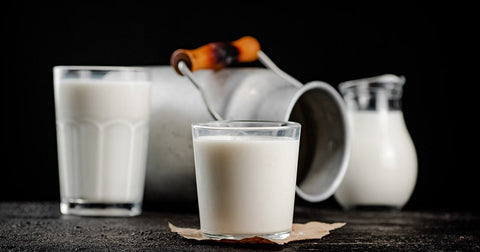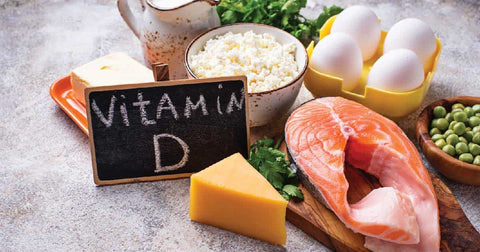Buttermilk is a byproduct of making butter, which has a tangy flavor and a thicker consistency than milk. It can also be produced by fermenting milk with lactic acid-secreting bacteria. So, modern buttermilk is a combination of water, milk lactose, and casein. There are different substitutes for buttermilk, which can be made easily. Some of the replacements are dairy-based and others are non-dairy-based.
Buttermilk provides a light and moist texture to baked foods like biscuits, pancakes, waffles, muffins, and cakes. So, it is also used while baking such products. It is used for baking because the acid in buttermilk reacts with baking soda to create aeration, resulting in great-tasting light and fluffy bakery products.
There are also certain health benefits to buttermilk. It is highly nutritious and provides a good source of vitamin D, calcium, vitamin B12, and other vitamins and minerals. Buttermilk also provides a good source of carbohydrates and protein. However, it may not be available everywhere, and some people cannot consume it due to health conditions or dietary restrictions.
So, there are certain substitutes for buttermilk that can be prepared at home using dairy or non-dairy components
What is buttermilk?
Buttermilk is the fermented form of milk with a sour or tangy flavor and a creamy texture. Contrary to its name, it does not contain butter. It is so named because, traditionally, it was formed as a leftover liquid when milk was churned into butter.
What is the use of buttermilk?
 Buttermilk has multiple uses because of its taste, acidic nature, and creamy texture. Some of the common uses of buttermilk are:
Buttermilk has multiple uses because of its taste, acidic nature, and creamy texture. Some of the common uses of buttermilk are:
- It is used as a common recipe for baking foods such as biscuits, pies, cakes, bread, and muffins.
- It is used for dressing salads.
- The tangy taste and creamy texture also make it suitable for marinating meat before cooking.
- Traditionally, it was also used as a refreshing beverage.
- Buttermilk was also used as a home remedy for cold sores.
- It has also got nutritional benefits, as it is a good source of vitamin B12, calcium, and vitamin D.
Substitutes for buttermilk
An acidic agent and liquid are key ingredients in making a buttermilk replacement. An acidic agent like lemon can be mixed with a liquid agent like dairy milk or soy milk to prepare a buttermilk substitute. The acid is used for the tangy taste of buttermilk and is also useful for making bakery food products.
So, we can divide the substitutes for buttermilk into using dairy-based products and using non-dairy-based products.
Dairy-based substitutes for buttermilk

- Milk and vinegar: Vinegar acts as an acidic agent, which can be added to the milk for buttermilk replacement. The vinegar that can be added can be apple cider or distilled white vinegar. The flavored vinegar might alter the taste. So, distilled white vinegar should be preferred.
You can also use various types of milk to prepare the buttermilk substitute you want. You can add 15ml (1 tablespoonful) of vinegar to 240 ml of milk to make a cup (240ml) of buttermilk. Then, you need to stir the solution and wait for 5 minutes before using it.
-
Milk and lemon juice: Instead of vinegar, lemon juice can also be used as an acidifying agent, which forms a buttermilk replacement, easily prepared at home. The amount of lemon juice required to make 1 cup of buttermilk is 15 ml. You can use lemon juice by squeezing fresh lemon or use packaged lemon juice. We would recommend using fresh lemons, as they are free of preservatives used in bottled lemon juice.
-
Milk and cream of tartar: cream of tartar contains a chemical known as potassium bitartrate, which acidifies the milk, providing a buttermilk alternative. Cream of tartar is a byproduct of making wine. For a cup of buttermilk, you should add 5 grams of cream of tartar to 240 ml of milk.
- Lactose-free milk and acid: buttermilk is usually lower in lactose than regular milk. So, people with lactose intolerance might have no symptoms while consuming buttermilk. However, you should not consume it if you have severe lactose intolerance. You can add the above-mentioned acidic ingredients like vinegar or lemon juice to the lactose-free milk if you want to consume a substitute that is free of lactose.
Additionally, people with lactose intolerance can also try vegan alternatives to buttermilk.
-
Sour cream: Sour cream has a tangy flavor like that of buttermilk and is made by fermenting cream with lactic acid-producing bacteria. Although other substitutes might not match the taste of actual buttermilk, the taste of sour cream is closest to the actual taste of buttermilk. Since sour cream is thicker, you can add water or milk to the cream to achieve a similar consistency. To substitute for 1 cup of buttermilk, you can add ¾ cup of sour cream with ¼ (60 ml) of milk or water. You can also adjust the amount of water according to the texture you would like.
-
Plain yogurt: Yogurt also provides a tangy flavor like buttermilk. Since it is also thicker than buttermilk, you can add some water or milk to plain yogurt to make a buttermilk replacement. You can add 60 ml of water or milk to 170 g of plain yogurt to make 1 cup of buttermilk alternative. The product is useful for marinades, dressing salads, and also for baking. Yogurt has further benefits than buttermilk, as it also improves gut health by increasing the number of good bacteria.
-
Plain kefir: Plain kefir has a similar consistency and flavor to buttermilk. So, you do not need to add water or milk to make a substitute for buttermilk. Buttermilk does not contain good bacteria and microbes, but kefir contains good bacteria to improve gut health, providing further health benefits.
- Buttermilk powder: A dehydrated powder form of buttermilk is also available. You can make buttermilk by adding water to the buttermilk powder. You might need 30 grams of buttermilk powder to make a cup of buttermilk
Dairy-free substitutes
You can also make dairy-free substitutes for buttermilk, which is appropriate for vegans and people with lactose intolerance.
Some dairy-free alternatives to buttermilk are:

-
Soy milk and acid: an unsweetened form of soy milk can be used with any agent that contains acidic ingredients such as vinegar, lemon juice, or cream of tartar, to make a buttermilk substitute. 1 tablespoonful of vinegar or lemon juice can be used to make a cup of buttermilk.
-
Vegan sour cream: Instead of regular sour cream, you can use vegan sour cream and add some water to get the consistency of buttermilk.
-
Tofu, water, and acid: You can use a blender to get soft, silken tofu; add water, and acidic agents like lemon juice or vinegar to get a buttermilk substitute.
-
Coconut milk and acid: The consistency of coconut milk is similar to that of buttermilk. So, you can add lemon juice or vinegar to the coconut milk for buttermilk replacement.
-
Almond milk and acid: unsweetened almond milk with lemon juice or vinegar can also be a substitute for buttermilk
-
Cashew milk and acid: similar to coconut milk and almond milk, cashew milk can also be used for making buttermilk substitutes.
- Homemade nut cream: Nut cream can be used as a substitute for buttermilk to prepare homemade baked goods. To make nut cream, soak a cup of unsalted nuts and put them in a blender after draining water. After that, blend them in a blender with a cup of water and a tablespoon of an acid such as lemon juice or white vinegar. Adjust the amount of water to the consistency of buttermilk.
Conclusion
Buttermilk is fermented milk with a typical tangy flavor. In the past, when people used to rear cattle, it was commonly found in people’s kitchens and was also considered a refreshing beverage. Today, it is made by adding lactic acid to milk. However, it is no longer a common ingredient present in people’s kitchens. So, if you need buttermilk for the baking recipes for making pancakes, muffins, or biscuits, it might be difficult for you to find at home. In such conditions, you can make a substitute for buttermilk with a common ingredient that is usually available in your kitchen.
The ingredients used can be dairy-based or non-dairy-based. One of the easiest ways to make a dairy-based buttermilk alternative is to add vinegar or lemon juice to the milk. If you follow a vegan diet, then you can use various non-dairy alternatives such as soy milk, coconut milk, and nut cream. However, to get the tangy flavor, you need to use the unsweetened form of these ingredients.
So, if you are planning for baking foods, and worried about getting buttermilk, you can use these substitutes for buttermilk.
Watch AFIL test kits testimonial videos click here
Sources:
- Yu, J., Mo, L., Pan, L., Yao, C., Ren, D., An, X., ... & Liu, W. (2018). Bacterial microbiota and metabolic character of traditional sour cream and butter in Buryatia, Russia. Frontiers in Microbiology, 9, 2496.
- Rasouli Pirouzian, H., Alakas, E., Cayir, M., Yakisik, E., Toker, O. S., Kaya, Ş., & Tanyeri, O. (2021). Buttermilk as milk powder and whey substitute in compound milk chocolate: Comparative study and optimisation. International Journal of Dairy Technology, 74(1), 246-257.
- Crisp, R. H. (1949). A substitute for buttermilk and its use in infant feeding. Medical Journal of Australia, 1, 717-719.
- Scheidegger, H. (1941). Skimmed milk acidified with lactic or citric acid as a substitute for buttermilk. Ann. paediat., 157, 101-128.
- Ozturkoglu-Budak, S., Akal, H. C., & Türkmen, N. (2021). Use of kefir and buttermilk to produce an innovative quark cheese. Journal of Food Science and Technology, 58(1), 74-84.
- Ognean, M., Ognean, C. F., & Hogea, S. (2019, November). New Ingredient in Bakery, Technological and Nutritional Effects of Buttermilk. In 1st International Symposium Innovations in Life Sciences (ISILS 2019) (pp. 325-328). Atlantis Press.


.png?v=1737390083)
.png?v=1737187409)


